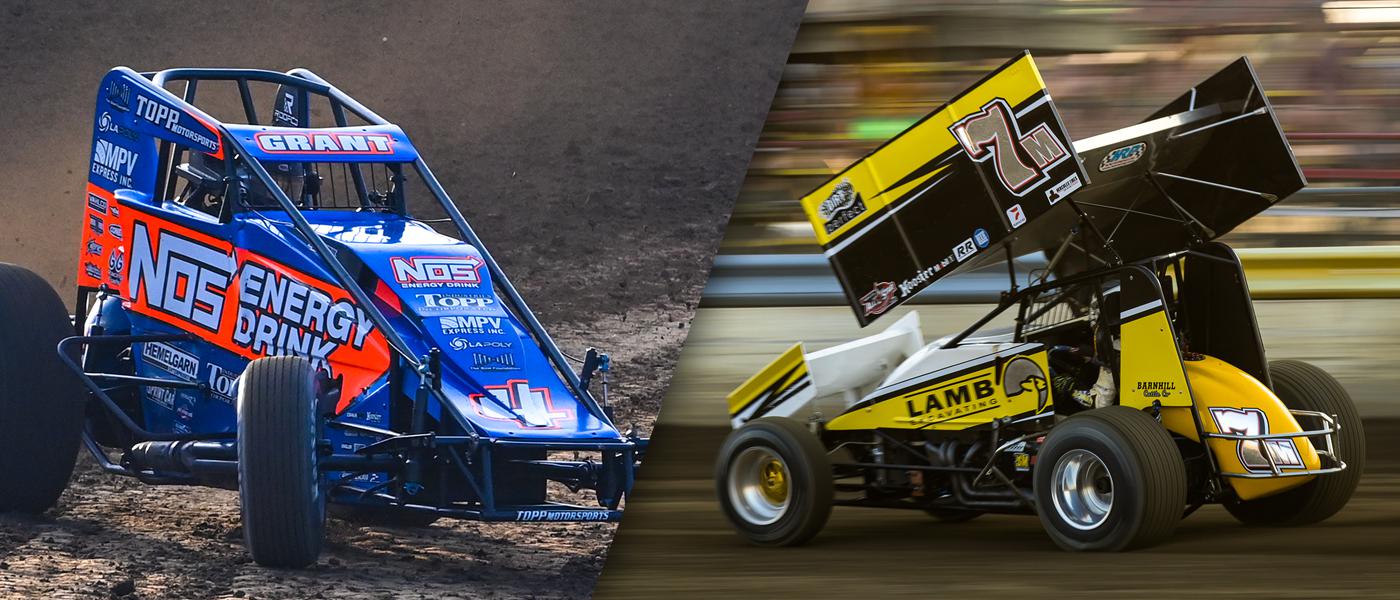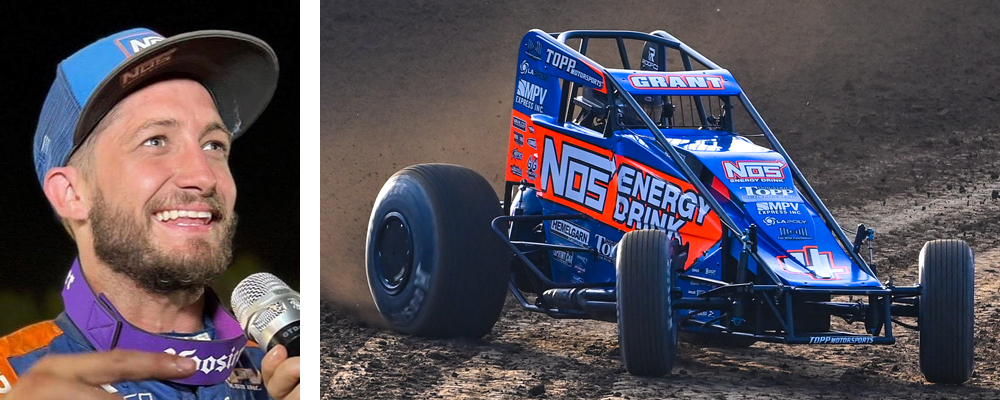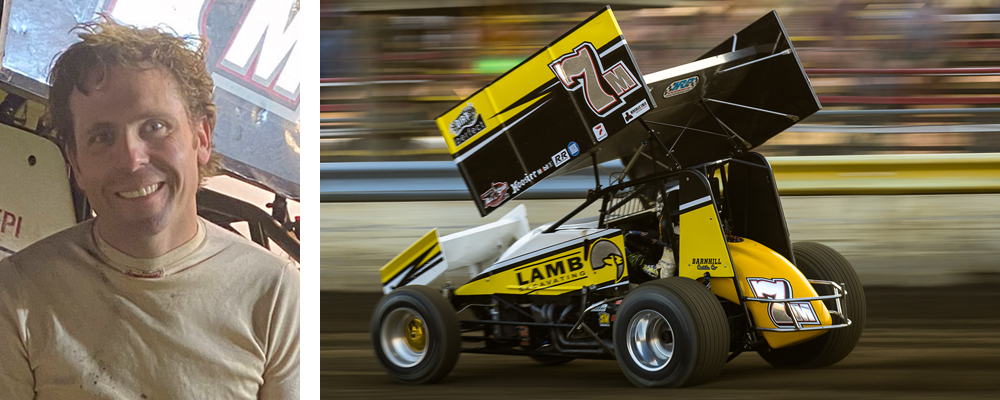Make The Case: Winged Vs. Non-Winged Sprint Car Racing

While the two machines are very similar, the downforce offered by winged sprint cars necessitates a unique approach to racecraft, setup, and technique. But for many racers, the choice between the two often comes down to driver preference and where the opportunities exist.
Non-Winged Sprint Cars:
Justin Grant,
USAC AMSOIL Sprint Car Racer

I started out racing midgets in California, and then I moved to Indiana to crew for a team for a year or so before I was able to get into a non-wing sprint car. I ran at a lot of local Indiana tracks for a while, and 2017 was the first year I followed the whole USAC schedule. Growing up in Northern California, which is kind of winged sprint car country, I remember watching the Sprint Week DVDs back in the day and thinking that the non-wing sprint cars were really cool. I always liked the wild nature they have. They’re rowdy, and they spend a lot of time going sideways. That was exciting to me—it has sort of an ‘X-Games’ factor built into it. But I like sprint cars in general, and what ultimately drew me toward non-wing cars is that it’s simply where the opportunities presented themselves.
For a time, I think that the non-wing racing was more fun to watch because there was more opportunity for passing, but the winged cars have started to catch up in that regard in recent years. Still, the lack of a wing on these cars changes things up significantly in terms of both driving technique and car setup, which is interesting in and of itself. I think that at times the lack of stability in these cars requires a little more of the driver to get the job done, whereas things are happening so fast with the winged cars that it’s more about the ability to react and quickly make decisions. Although the non-wing cars are less stable and a bit sketchier in turns, things are happening at a slower rate, and that allows you to be more deliberate about strategy.
In a non-wing sprint car you can also run right on the back of a guy, but with the winged sprint cars you have to worry about your position relative to the other cars on track and how that’s going to affect the air that’s getting to you. With a non-wing car that’s not really a factor—the air doesn’t really have any effect on how fast the car is going to run or how much grip you have. That opens up your options a little bit more. Instead of being concerned about downforce, in a non-wing car you’re really more concerned about finding moisture on the track to maintain those grip levels. Conditions change as the cars are running, so you spend more time searching for what’s left of the race track. You’re always looking for some moisture for your tires in the non-wing cars. With a wing car you can just get grip with more mph—the faster you go, the more downforce the wing generates.
The lack of downforce on non-wing cars means that the approach to setup is pretty different, too. We set our cars a lot lower in the back, so our left rear corner sits a lot closer to the ground. Our right-side tires are also a lot further out because that exaggerated offset adds some stability to the car. We’re basically trying to create the same attitude of the winged sprint cars without the downforce, so we’ll run a lot more rebound in our left-rear shock just to try and hold that corner down.
I came up through quarter-midgets and outlaw karts, and I’ve noticed that the kids who are coming out of the 600cc micro sprints are switched on really quick. But I don’t know if there’s anything that can truly prep you for the way that you need to drive non-wing sprint cars. You’re so sideways in these things, and you have to really bend the car around to get it into a corner. In most everything else you’re leading with the front tires. With a non-wing sprint car, you’re basically steering with the throttle.
Winged Sprint Cars:
Geoff Dodge,
World of Outlaws NOS Energy Drink Sprint Car Series Racer

I started off in karting, and early on I was mostly focused on road racing. I had ambitions of going to Indy, but the budget was not going to allow for it, so I got to a point where I couldn’t take the next step and I had to make a decision. My dad was a sprint car racer and I grew up around it, so I naturally gravitated in that direction at that point. At the time there was still a decent number of car owners in the game, and I felt like there might be an opportunity to get hired to drive someone’s race car. I started in winged 360s back in 2003, and by 2005, someone put me in their race car, which gave me my first shot at winged 410 racing. In 2007, I also did some 410 non-wing racing. While I like both winged and non-winged cars, I was more competitive in the winged cars, and I enjoyed it a little more.
When I got into sprint cars, I wanted to stand on the gas and go as fast as I could, and the non-winged cars feel kind of slow by comparison. The World of Outlaws is also just the greatest show on dirt, and part of the allure was the big names, the big purses, and being on the road. All of that sounded pretty cool as a young kid. Watching my dad race winged sprint cars locally was a major factor, too.
Ultimately winged sprint cars are capable of doing things that a non-winged sprint car just can’t do. You’ve got more downforce at 100 mph than the car itself weighs, and that has a profound effect on the car’s behavior at speed. In a winged sprint car you not only have the grip levels of different tracks and the things you can do based on those conditions, but you also have an added
layer of aerodynamic grip based on setup and what the other cars around you are doing. It brings another level of complexity to the racing. A non-winged sprint car is probably a little bit harder to get around the race track, but a winged sprint car is harder to be truly competitive in. It takes a lot longer to get good with these cars.
Winged cars also require a very different approach to setup because the ride height changes significantly at speed, whereas a non-wing sprint car doesn’t have something pushing down on it more and more the faster you go. That said, I think the most important thing is to give the driver the feel they need to drive the car as hard as it needs to be driven to win. You don’t see everybody doing the exact same tricks on their cars—it’s really just about giving the driver the confidence to drive wide open into a corner. More speed equals more grip here.
Because of that, I also think it’s really important to build a strong relationship with whoever is doing your engines. In winged sprint car racing the faster you go, the better the car works. So if you don’t have your engine running hard, you can’t really begin to work on the rest of the car. If you find another 2 mph of straightaway speed, you might discover that it fixes that handling problem you were chasing. But for the aero to work right, the engine needs to work right, too. Winged sprint cars are more competitive than ever now, and small things can be the difference between success and failure.
 MEMBERSHIP LOGIN
MEMBERSHIP LOGIN JOIN PRI
JOIN PRI


